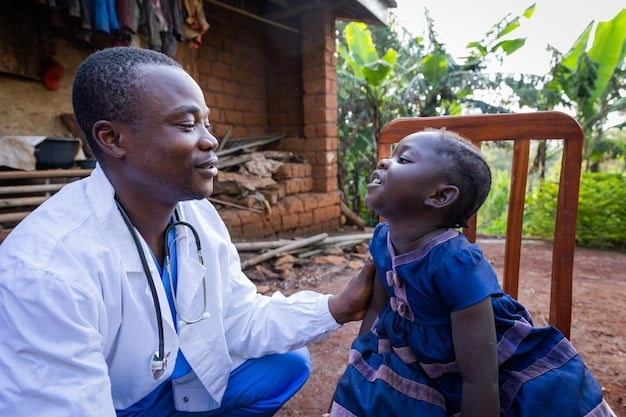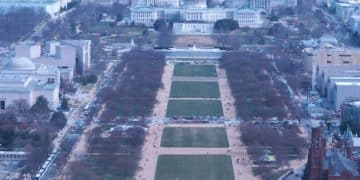Analyzing the Impact: A 10% Cut in US Aid to Africa

Analyzing the potential consequences of a 10% reduction in foreign aid to Africa from a U.S. foreign policy perspective involves assessing economic, political, and humanitarian impacts, considering alternative aid strategies, and understanding the shifting dynamics of international relations.
The United States’ foreign aid to Africa has long been a focal point of both support and scrutiny. Analyzing the potential consequences of a 10% reduction in foreign aid to Africa: A US Foreign Policy Perspective, requires a comprehensive look at the anticipated multi-faceted consequences of such a policy shift. Understanding these potential outcomes is essential for informed decision-making and effective foreign policy.
Understanding US Foreign Aid to Africa
US foreign aid to Africa encompasses a range of programs aimed at promoting economic development, improving healthcare, fostering democracy, and ensuring security. These initiatives address challenges such as poverty, disease, conflict, and governance, with the ultimate goal of creating stable, prosperous, and democratic societies. Let’s delve into the specifics of this aid.
Types of Aid Provided
US foreign aid is not monolithic; it is distributed through various channels and targets diverse sectors. Understanding these different types is crucial to evaluating the potential impact of a reduction.
- Economic Assistance: Funds allocated to support infrastructure development, promote trade, and enhance economic growth.
- Health Programs: Investments in combating diseases like HIV/AIDS, malaria, and tuberculosis, as well as strengthening healthcare systems.
- Humanitarian Aid: Emergency relief provided in response to natural disasters, conflicts, and other crises.
- Security Assistance: Support for military training, equipment, and peacekeeping operations to enhance stability and counter terrorism.
The effectiveness of these different aid streams varies, and a reduction in one area may have more significant repercussions than in another.
Key Recipient Countries
While US foreign aid is distributed across many African nations, certain countries receive a larger share due to strategic importance, developmental needs, or historical ties.
Countries like Ethiopia, Kenya, Nigeria, and South Africa are among the largest recipients of US aid. Each of these nations faces unique challenges, and the impact of a 10% reduction could vary significantly depending on the specific programs affected.
Understanding the intricacies of US foreign aid structures and recipient nations sets the stage for a thorough analysis of the potential consequences of a reduction.
Potential Economic Impacts
A 10% reduction in US foreign aid to Africa could trigger a cascade of economic effects, impacting various sectors and populations. Understanding these implications is crucial for policymakers.

Reduced Investment and Economic Growth
Foreign aid often serves as a catalyst for investment, stimulating economic activity and creating jobs. A 10% reduction could curtail these benefits, leading to slower growth rates.
- Impact on Infrastructure: Projects related to roads, energy, and water systems could face delays or cancellations, hindering long-term development.
- Reduced Job Creation: Smaller investments translate to fewer job opportunities, particularly for young people entering the workforce.
- Trade Barriers: Diminished aid could affect trade facilitation programs, making it harder for African businesses to compete in the global market.
These economic setbacks could exacerbate existing challenges, making it harder for African nations to achieve sustainable development goals.
Effects on Poverty and Inequality
Economic aid programs often target poverty reduction, providing resources and opportunities for marginalized communities. A reduction in aid could disproportionately affect these vulnerable populations.
Poverty rates could increase as programs providing essential services and income support are scaled back. Inequality may also widen, as wealthier segments of society are better equipped to withstand economic shocks.
The economic consequences of a US foreign aid cut in Africa could be far-reaching, affecting everything from infrastructure to individual livelihoods.
Impacts on Healthcare and Humanitarian Aid
US foreign aid plays a pivotal role in supporting healthcare systems and providing humanitarian relief across Africa. Analyzing the potential consequences of a reduction in these areas is vital.
Healthcare System Strain
US aid supports numerous health programs, including those focused on combating infectious diseases, improving maternal and child health, and strengthening healthcare infrastructure.
- Disease Control: Reduction in funding for programs targeting HIV/AIDS, malaria, and tuberculosis could lead to resurgence of these diseases.
- Maternal and Child Health: Cuts in aid could affect access to prenatal care, vaccinations, and essential medicines, increasing mortality rates.
- Infrastructure Gaps: Healthcare facilities may struggle to maintain operations, leading to reduced access to medical services for communities.
These healthcare challenges could undo years of progress and exacerbate existing health crises.
Humanitarian Response Capacity
Africa is prone to natural disasters, conflicts, and other humanitarian crises. US aid provides essential relief during these events. A reduction in aid could severely hamper response capabilities.

Emergency food assistance, shelter, and medical care may be curtailed, leaving affected populations more vulnerable. Coordination with international organizations and local NGOs could also suffer, hindering the effectiveness of humanitarian operations.
A cut in US foreign aid would not only limit the short-term ability to respond to humanitarian crises but also undermine long-term resilience-building efforts.
Political and Security Implications
Beyond economics and healthcare, US foreign aid has significant political and security dimensions. Evaluating these impacts is critical for understanding the full scope of the consequences.
Security and Stability
US aid supports security initiatives aimed at countering terrorism, promoting peacekeeping, and stabilizing conflict-affected regions. A reduction could undermine these efforts.
Military training and equipment assistance may be reduced, weakening the capacity of African forces to address security threats. Peacekeeping operations could also be affected, potentially leading to increased instability and violence.
A weakened security environment could have spillover effects, impacting neighboring countries and potentially fostering regional conflicts.
Governance and Democracy
US foreign aid supports programs promoting good governance, democracy, and human rights. A reduction could weaken these initiatives.
Support for electoral processes, civil society organizations, and judicial reforms may be curtailed, potentially leading to democratic backsliding. Anti-corruption efforts could also suffer, exacerbating problems of graft and mismanagement.
The political consequences of a US foreign aid cut could undermine progress made in governance and democratization, posing significant challenges to African nations.
Alternatives and Mitigation Strategies
If a 10% reduction in US foreign aid is implemented, it is crucial to explore alternative strategies to mitigate its negative impacts.
One approach is to prioritize aid allocation, focusing on programs with the greatest impact and potential for sustainability. Strengthening partnerships with other donor countries and international organizations can also help to address funding gaps.
Leveraging Private Sector Investment
Encouraging private sector investment can complement foreign aid, providing additional capital and expertise. This can be achieved through incentives, guarantees, and regulatory reforms that attract foreign investment.
Private sector initiatives can support infrastructure development, job creation, and technology transfer, contributing to long-term economic growth.
Enhancing Local Capacity
Building the capacity of local institutions and civil society organizations is essential for ensuring the sustainability of development efforts. This involves providing training, technical assistance, and resources to strengthen local expertise and leadership.
By empowering local actors, African nations can become less reliant on foreign aid and more capable of addressing their own challenges.
Conclusion
Analyzing the potential consequences of a 10% reduction in US foreign aid to Africa reveals a complex web of economic, healthcare, political, and security implications. While mitigation strategies can help to offset some of these negative effects, it is imperative for policymakers to carefully consider the potential costs and benefits of such a policy shift.
| Key Point | Brief Description |
|---|---|
| 📉 Economic Decline | Reduced investment, slower growth, and job losses can hinder long-term economic development. |
| 🩺 Healthcare Crisis | Disease resurgence, reduced maternal care, and weakened healthcare infrastructure can lead to health crises. |
| 🛡️ Security Risks | Weakened security capacity, potential instability, and challenges to peacekeeping efforts can increase risks. |
| 🏛️ Governance Issues | Democratic backsliding, corruption, and weakened civil society can undermine governance and human rights. |
Frequently Asked Questions
▼
US foreign aid primarily aims to promote economic development, improve healthcare, foster democracy, and ensure security across the African continent.
▼
Healthcare, economic development, humanitarian assistance, and security programs are sectors that could be significantly impacted by a 10% aid reduction.
▼
Reduced funding could lead to a resurgence of diseases, decreased access to maternal and child health services, and strained healthcare infrastructure across Africa.
▼
Prioritizing aid allocation, leveraging private sector investment, and enhancing local capacity are several key alternative strategies for reducing the impact.
▼
Cuts could weaken the capacity of African forces, potentially leading to instability, increased violence, and hindering peacekeeping operations in the region.
Conclusion
In conclusion, a reduction in US foreign aid to Africa poses multifaceted challenges, impacting economic stability, healthcare, and security. Careful consideration of mitigation strategies and alternative approaches is essential to minimize adverse outcomes and maintain progress towards development goals.





